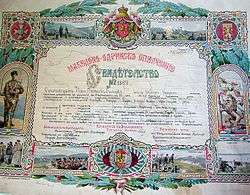Flămânda Offensive
| Flămânda Offensive | |||||||
|---|---|---|---|---|---|---|---|
| Part of Romanian Campaign (World War I) | |||||||
 Romanian 10th Division crossing the Danube at Flămânda/Ryahovo | |||||||
| |||||||
| Belligerents | |||||||
|
|
| ||||||
| Commanders and leaders | |||||||
|
|
| ||||||
| Strength | |||||||
|
186 infantry battalions 55 cavalry squadrons 148 artillery batteries |
105 infantry battalions 35 cavalry squadrons 70 artillery batteries | ||||||
| Casualties and losses | |||||||
| Nearly 3,000 killed, wounded, missing or captured |
Bulgaria: 300 killed, wounded or missing Germany: Unknown | ||||||
| ||||||
The Flămânda Offensive (or Flămânda Maneuver, which took place between 29 September and 5 October 1916, was an offensive across the Danube mounted by the Romanian 2nd Army during World War I. The battle represented a consistent effort by the Romanian Army to stop the Central Powers south offensive led by August von Mackensen. The battle ended as a tactical victory for the Central Powers.
Background


Romania begun its World War I in August 1916, when Romanian forces invaded Transylvania passing the border on the Carpathian Mountains. The Romanian forces quickly defeated the small number of Austro-Hungarian forces based in the border area and started their advance into Austro-Hungarian territory, but they were halted soon. Meanwhile, a Central Powers force comprising Bulgarian, German and Turkish troops and led by August von Mackensen entered Dobruja in southeastern Romania.[1]
Facing more serious threats than expected, the Romanian Crown Council decided to reinforce the 3rd Army, led by General Alexandru Averescu, by 150,000 men. Averescu consequently was put in charge of an army group consisting of the 3rd Army and the 50,000 men Army of the Dobruja commanded by general Andrei Zayonchkovski, comprising 17 divisions and planned to counterattack Mackensen's forces across the Danube River from behind. The plan was to attack the Central Powers forces from the rear by crossing the Danube at Flămânda, while the front-line Romanian and Russian forces were supposed to launch an offensive southwards towards Cobadin and Kurtbunar (today Tervel, Dobrich Province). The idea was to cut off Mackensen's army from its bases in northern Bulgaria.[1]
The battle
The attack commenced on 29 September on a 50 miles (80 km) wide front from Flămânda, near Oltenița, to Zimnicea in the direction of Mackensen's western flank, with the Romanian forces enjoying superiority in numbers of infantry personnel and artillery equipment. However, the Romanian struggle to cross the Danube was slowed by the Austro-Hungarian Navy's Danube Flotilla.[1]
On October 1, two Romanian divisions crossed the Danube at Flămânda and created a bridgehead 14 kilometer-wide and 4 kilometer-deep. On the same day, the joint Romanian and Russian divisions went on offensive on the Dobruja front, however with little success. In the night between 1/2 October a heavy storm caused heavy damages to the pontoon bridge Romanian forces were using to pass the Danube. The failure to break the Dobruja front, culminating with the heavy infantry fighting in the vicinity of Flămânda on 3 October, led General Averescu to cancel the whole operation and concentrate its forces to counter the Central Powers offensive from Transylvania.[2]
Aftermath
The Danube remained a barrier to military operations until half of Mackensen's army crossed it in late November, 1916.
References
Notes
Bibliography
- Spencer Tucker, Priscilla Mary Roberts (2005). Encyclopedia of World War I. ABC-Clio. ISBN 1-85109-420-2.
External links
- (English) The Flămânda Maneuver on worldwar2.ro
Coordinates: 43°59′15″N 26°14′42″E / 43.98750°N 26.24500°E

